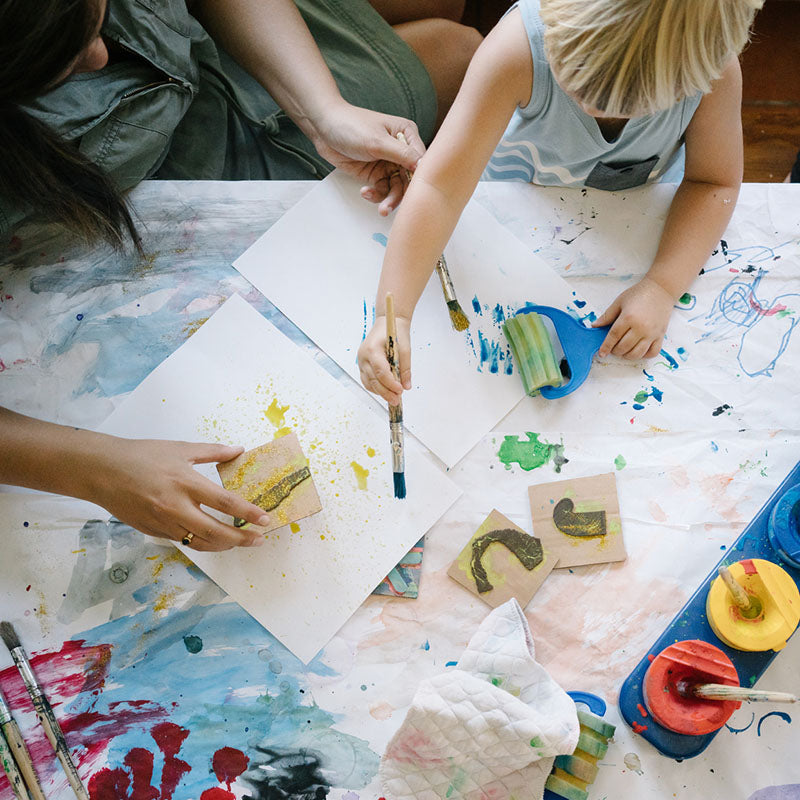We have all been in a situation where our kids beg us to do a messy activity like making slime, finger painting, or digging in kinetic sand and our anxiety kicks in. Where kids see exploration and fun, it can be easy for us as adults to only see the mess and work instead of the numerous developmental benefits. Type A parents of the world unite because it can feel impossible and frustrating to even contemplate pulling out the glitter or play-dough.
We want our children to have fun, but we can also vividly see the to-do list growing exponentially. If you are the type of caregiver whose anxiety spikes it may even feel like the fun is removed from these situations because of how worried you are about what comes after the messy sensory play is done.
This anxiety surrounding mess has been researched and the consensus is that clutter causes anxiety because all the extra stimuli pull our focus away from the things we need to focus on and that can trigger the release of more cortisol (the stress hormone) in your body. It is the reason that it can be so hard to stay engaged with a task when you have laundry piled up or dishes sitting in the sink. It is why even the thought of having to pick slime out of your carpet can bring out a quick no, not today.
Now that we understand why we as caregivers feel triggered by mess we can explore the benefits of creating space for messy play moments with our children. Children are like tiny scientists. They are constantly inquiring about the whys and hows. These everyday science experiments are how children figure out the world around them. You can see this beginning in the early years when a child begins to understand that crying leads to a reaction from their caregiver and their needs are met. They learn that If they shake a rattle it makes noise. As children grow and develop this curiosity continues to grow. Why is the grass green? If I drop this egg what will happen?
All these mini hypotheses lead to a more robust understanding of how the world works and how they fit into that world. For example, when your child thinks, what will happen when I drop this egg? They may have a few different scenarios in their mind. Maybe it will bounce? Maybe it will make a loud noise? Maybe it will have a chick inside or candy? So they throw the egg and what does it do? It smashes on the floor and cracks open and all the egg and yolk come oozing out. Now we see a mistake and a mess to clean, but your child just learned a small physics lesson. Now they don’t see a mess, they see an uncooked egg and without guidance what might they do with that egg and yolk? If we don’t intervene when it is safe to let children explore we allow them the space to learn through doing.
Messy play also has the added benefit of sensory exploration. Sensory exploration is when your child can play while engaging any of their 5 senses (sight, taste, smell, feel, and hear) and through this, they are supporting their cognitive development by creating more neural pathways in the brain. These new pathways are supporting problem-solving skills, self-esteem, confidence, motor skills, and even language development.
So while we see smooshed water beads in the yard or play-dough on all surfaces, this kind of play is a critical part of development. Now for the helpful part, how can I help my child engage in this style of play when it causes me so much anxiety. Here is a shortlist of ideas that can help keep messy play engaging and fun, while also not adding a huge list of chores to your list.
- Sensory Play Colored Noodle Activity:
- Supplies
- 1 box of spaghetti noodles
- 1 set of food coloring
- 5 tablespoons of oil (coconut oil works well)
- 5 plastic bags
- Small toys (cars, letters, shapes, etc)
- Instructions
- Rainbow Pom Pom Color Activity
- Supplies
- Tongs
- Pom poms in multiple colors
- A plastic bin
- Plastic bottles/buckets/bowls
- Instructions
- Oil and Water Sensory Bag
- Supplies
- Gallon ziplock bag
- Water
- Oil
- Food coloring
- Instructions
If all else fails, playing outside and exploring nature offers numerous textures, sights, smells, and sounds to explore and discover. What are some of your favorite sensory play ideas? Please share in the comments below to help out fellow caregivers who may struggle with finding ways to engage with “messy play”.










